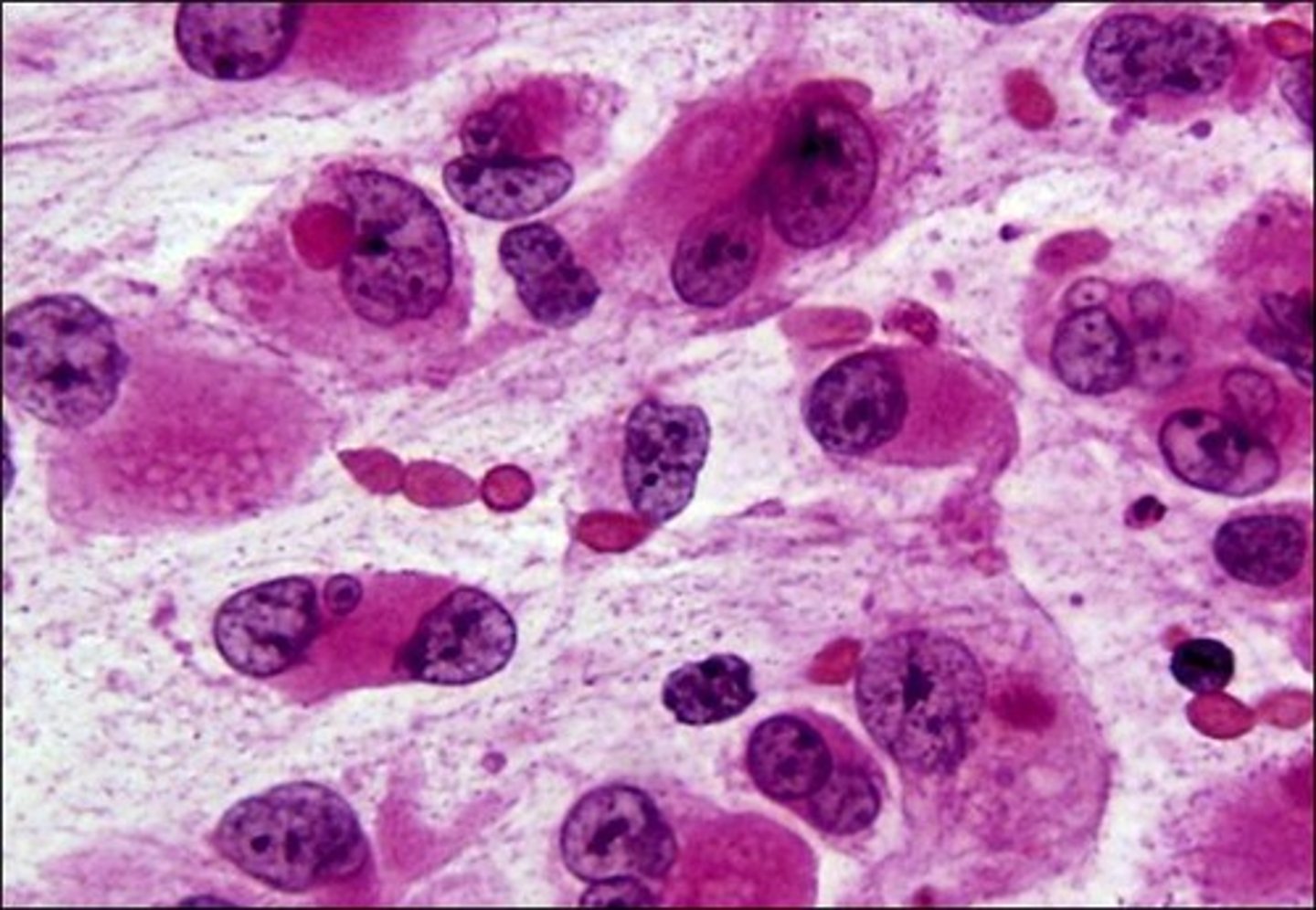48. Renal tumours (oncocytoma, renocellular cancer, Wilms tumor, urothelial carcinoma of the renal pelvis)
1/33
There's no tags or description
Looks like no tags are added yet.
Name | Mastery | Learn | Test | Matching | Spaced |
|---|
No study sessions yet.
34 Terms
Most common tumors of urinary tract?
- Oncocytoma
- Renal cell carcinoma
Benign renal cell tumors?
- Oncocytoma
- Angiomyolipoma
- Papillary adenoma
Oncocytoma?
Benign renal tumor
- Originates from intercalated cells of the tubules -> "oncocytes"
Tumor is brown on macroscopy
- Can be hard to differentiate from chromophobe RCC (must use cytogenetics)
Oncocytes?
Cells with large eosinophilic cytoplasm -> due to high content of mitochondria
Angiomyolipoma?
Hamartoma of the kidney
Comprised of:
- Blood vessels, smooth m.m. and adipose tissue
More frequent in patients with tuberous sclerosis
What is a hamartoma?
Disorganized tissue that is composed of correct tissue for the location
- Not dysplastic
- Not cancerous
Papillary adenoma?
Small (5mm) and grey benign tumor of the kidney
- Always within the cortex
Renal cell carcinoma?
Malignant epithelial tumor
- Arising from kidney tubules
- Represents 80% of all primary malignant tumors of the kidney
Classic triad of RCC?
- Hematuria (with normal RBCs)
- Flank pain
- Palpable mass on flank
(also... non-specific symptoms like fever & weight loss)
Most important risk factors for RCC are?
- Smoking
- Cystic disease of kidney
- Obesity
- Hypertension
Types of RCC according to histology?
- Clear cell RCC - 65%
- Papillary RCC - 10%
- Chromophobe RCC - 5%
- Cystic RCC - 2,5%
- Collecting duct RCC - 1%
Clear cell RCC?
Clear cytoplasm of tumor cells
= High fat content of cell -> why tumor looks yellow on macro
- Can have capsule -> can mimic benign tumor
- Occurs on lower pole
- Clear cell carcinoma has worse prognosis than the next 2
Genetics of clear cell RCC?
Loss of tumor-suppressor VHL on chromosome 3p25
- Either sporadic or hereditary as is the case in von Hippel-Lindau disease
- 50% with this disease develop clear RCC
- Often multiple & bilateral tumors in VHL-disease
Papillary RCC?
Papillary growth pattern
- Tumors appear in multiple foci and bilaterally
Genetics of papillary RCC?
MET proto-oncogene on chromosome 7q31
- is associated - both in hereditary and sporadic forms
Chromophobe RCC?
Tumor cells stain darkly
- Tumor cells have usually lost multiple chromosomes -> making them hypoploid
- Good prognosis
Hypoploid?
Fewer than the normal chromosome number
Cystic RCC?
Rare type of RCC that is commonly misdiagnosed as a benign renal cyst
- Excellent prognosis after surgical removal
Collecting duct RCC?
Very rare subtype
- Very aggressive
- BAD prognosis
Paraneoplastic syndromes of RCC?
- Hypertension (can produce renin)
- Hypercalcemia (Produce PTH-related-protein)
- Polycythemia - (EPO production)
- Secondary hypercortisolism - as it can produce ACTH (Cushing)
What can RCC cause in the scrotum?
Left-sided varicoele
- Pathological dilation of the venous plexus of the scrotum
Where does RCC spread?
Spreads locally to the renal vein
- Can block the point where left testicular vein drains into the renal vein
= Pressure builds up in the venous plexus of the scrotum -> soft lump
Metastasis of RCC?
- Lung
- Bones
most frequently
As it commonly grows to renal vein and IVC -> it can extend as far to the heart
Lymphatic spread:
- To retroperitoneal lymph nodes
Diagnosis of RCC?
Does not cause symptoms until later stages
- Often found incidentally
Up to 25% have already distant metastasis at diagnosis
Furhman system?
Grading system for kidney tumors
- Based on how prominent the nucleoli is
= More prominent -> the higher the grade is
A grade IV RCC ?
Has sarcomatoid or rhabdoid appearance
(Rod-shaped)

TNM staging of kidney tumors?
Depends on:
- Size of tumor
- Renal vein involvement
- Local invasion
• Kidney tumors commonly infiltrate the adipose capsule -> T3
• If they infiltrate beyond renal fascia -> T4 (inoperable)
Wilms tumor?
Nephroblastoma
- Most common malignant renal tumor in children
- Age of diagnosis: 3 y/o
- Rarely occurs in adults
What is Wilms tumor comprised of?
Blastema:
- Embryological tissue that the normal kidney develops from
- Tumor may have primitive glomeruli and tubules
Genetics of Wilms tumor?
Mutation of WT1 - a tumor suppressor gene
- This mutation often occurs in WAGR syndrome
WT1?
Regulates transcription of insulin-like growth factor, E-cadherin and PDGF
Is essential for renal & gonadal development
WAGR syndrome?
- Wilms tumor
- Aniridia
- Genital abnormalities
- Retardation
Syndrome is with germ-line deletion of WT1
- 1/3 will acquire "second hit" -> developing Wilms tumor
Denys-Drash syndrome?
Germ-line mutation (NOT deletion) in one allele of WT1
- Have 90% chance of developing Wilms tumor
They also have:
- Gonadal dysgenesis
- Early nephropathy
Histology of Wilms tumor?
Triphasic tumor - has 3 different parts:
1. Epithelial part
2. Stromal part
3. Blastema part -> has most clinical relevance. The more of this part, the poorer diagnosis